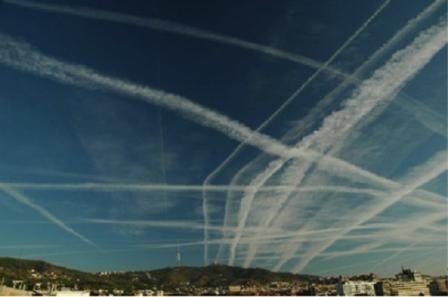A WRF Simulation of an Episode of Contrails Covering the Entire Sky
Abstract
:1. Introduction
2. Methodology
2.1. Observations
2.2. Synoptic Conditions
2.3. WRF Set-Up
3. Results
4. Conclusions
Acknowledgments
Author Contributions
Conflicts of Interest
References
- Appleman, H. The formation of exhaust condensation trails by jet aircraft. Bull. Am. Meteorol. Soc. 1953, 34, 14–20. [Google Scholar]
- Iribarne, J.V.; Godson, W.L. Atmospheric thermodynamics. Q. J. R. Meteorol. Soc. 1982, 108, 734–735. [Google Scholar]
- Gierens, K.M. Numerical simulations of persistent contrails. J. Atmos. Sci. 1996, 53, 3333–3348. [Google Scholar] [CrossRef]
- Boin, M.; Levnok, L. Numerical simulation of the life time of contrails. In Impact of Emissions from Aircraft and Spacecraft upon the Atmosphere, Proceedings of an international scientific colloquium, Cologne, Germany, 18–20 April 1994; Schumann, U., Wurzel, D., Eds.; DLR-Mitteilung 94-06, Deutsches Zentrum fur Luft- und Raumfahrt: Oberpfaffenhofen and Cologne, Germany; pp. 82–87.
- Schumann, U. On conditions for contrails formation from aircraft exhaust. Meteorol. Z. 1996, 5, 4–23. [Google Scholar]
- Karcher, B.; Biermann, P.; Schumann, U. The initial composition of jet condensation trails. J. Atmos. Sci. 1996, 53, 3066–3083. [Google Scholar] [CrossRef]
- Schumann, U.; Wending, P. Air Traffic and the Environmental—Background, Tendencies and Potential Global Atmospheric Effects; Springer–Verlag: Berlin/Heidelberg, Germany, 1990; p. 245. [Google Scholar]
- Minnis, P.; Young, D.F.; Garber, D.P.; Nguyen, I.; Smith, L.; Palikonda, R. Transformation of contrails into cirrus during SUCCES. Geophys. Res. Lett. 1998, 25, 1157–1160. [Google Scholar] [CrossRef]
- Mannstein, H.; Meyer, R.; Wending, P. Operational detection of contrails from NOAA–AVHRR–data. Int. Remote Sens. 1999, 20, 1641–1660. [Google Scholar] [CrossRef]
- Schröder, F.; Kärcher, B.; Duroure, C.; Ström, J.; Petzold, A.; Gayet, J.F.; Strauss, B.; Wendling, P.; Borrmann, S. On the transition of contrails into cirrus clouds. J. Atmos. Sci. 2000, 57, 464–480. [Google Scholar] [CrossRef]
- Minnis, P.; Ayers, J.; Palikonda, R.; Phan, D. Contrails, cirrus trends, and climate. J. Clim. 2004, 17, 1672–1685. [Google Scholar] [CrossRef]
- Burkhardt, U.; Kärcher, B. Global radiative forcing from contrail cirrus. Nat. Clim. Chang. 2011, 1, 54–58. [Google Scholar] [CrossRef]
- Stuefer, M.; Meng, X.; Wendler, G. MM5 contrail forecasting in Alaska. Mon. Weather Rev. 2005, 133, 3517–3526. [Google Scholar] [CrossRef]
- Liou, K.; Ou, S.S.; Kim, J.; Gu, Y.; Yang, P.; Friedl, R.R. Climate effects of contrails cirrus over the western United States: A regional climate model investigation. AGU Fall meeting Abstracts. Available online: https://jifresse.ucla.edu/research/publications-presentations/2009agu-liou.pdf (accessed on 16 July 2016).
- Skamarock, W.C.; Klemp, J.B.; Dudhia, J.; Gill, D.O.; Barker, D.M.; Duda, M.; Huang, X.Y.; Powers, J.G. A Description of the Advanced Research WRF Version 3; Technical Report TN–475+STR; NCAR: Boulder, CO, USA, 2008. [Google Scholar]
- Hong, S.H.; Pan, H.L. Nonlocal boundary layer vertical diffusion in a medium-range forecast model. Mon. Weather Rev. 1996, 124, 2322–2339. [Google Scholar] [CrossRef]
- Mlawer, E.; Tubman, S.J.; Brown, P.D.; Iacono, M.J.; Clough, S.A. Radiative transfer for inhomogeneus atmospheres: RRTM, a validated correlated–k model for the long wave. J. Geophys. Res. 1997, 102, 663–682. [Google Scholar]
- Dudhia, J. Numerical study of convection observed during the winter monsoon experiment using a mesoscale two-dimanesional model. J. Atmos. Sci. 1989, 46, 3077–3107. [Google Scholar] [CrossRef]
- Hong, S.; Dudhia, J.; Chen, S. A revised approach to ice microphysical processes for the bulk parameterization of clouds and precipitation. Mon. Weather Rev. 2004, 132, 103–120. [Google Scholar] [CrossRef]
- Lamquin, N.; Stubenrauch, C.J.; Greens, K.; Burkhardt, U.; Smit, H. A global climatology of upper-tropospheric ice supersaturation occurrence inferred from the Atmospheric Infrared Sounder calibrated by MOZAIC. Atmos. Chem. Phys. 2012, 12, 381–405. [Google Scholar] [CrossRef] [Green Version]
- Keckhut, P.; Borchi, F.; Bekki, S.; Hauchecorne, A.; Silaouina, M. Cirrus classification at mid-latitude from systematic liar observations. J. Appl. Meteorol. Climatol. 2006, 45, 249–258. [Google Scholar] [CrossRef]








© 2016 by the authors; licensee MDPI, Basel, Switzerland. This article is an open access article distributed under the terms and conditions of the Creative Commons Attribution (CC-BY) license (http://creativecommons.org/licenses/by/4.0/).
Share and Cite
Mazon, J.; Pino, D. A WRF Simulation of an Episode of Contrails Covering the Entire Sky. Atmosphere 2016, 7, 95. https://doi.org/10.3390/atmos7070095
Mazon J, Pino D. A WRF Simulation of an Episode of Contrails Covering the Entire Sky. Atmosphere. 2016; 7(7):95. https://doi.org/10.3390/atmos7070095
Chicago/Turabian StyleMazon, Jordi, and David Pino. 2016. "A WRF Simulation of an Episode of Contrails Covering the Entire Sky" Atmosphere 7, no. 7: 95. https://doi.org/10.3390/atmos7070095






